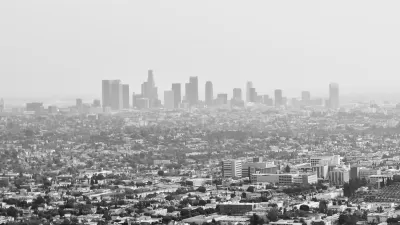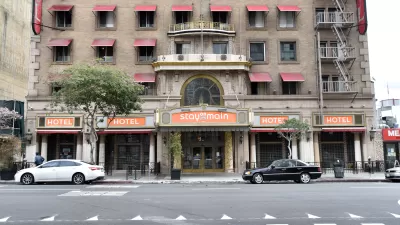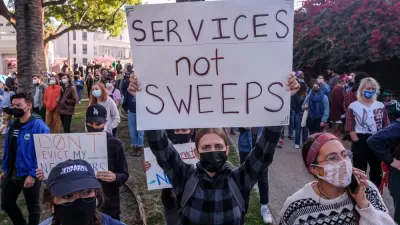The complex can house over 200 people and will provide bathrooms and social services for people transitioning out of homelessness.

Jesús Sanchez reports on the tiny home village now under construction in L.A.'s Highland Park neighborhood, an area that has, for years, been seen as a poster child for the gentrification of historically Latino neighborhoods. "The Arroyo Seco Tiny Home Village will consist of 115 cabins -- each measuring 8-feet-square," intended to house up to 224 people as transitional housing. "Tiny home villages are intended to last about three years and provide temporary housing until permanent homes can be found for residents."
The Hope of the Valley Rescue Mission, which operates other tiny home villages in Los Angeles, will provide security, manage the campus and oversee the social service agencies that offer services to help stabilize the residents as they wait for permanent housing placements. The Highland Park complex is considered to be the largest of its kind in the state, if not the country.
"Founded in the San Fernando Valley 12 years ago with the goal of breaking the cycle of homelessness and poverty, Hope of the Valley opened LA’s first tiny home village in North Hollywood six months ago and has since opened additional villages in North Hollywood’s Alexandria Park and Reseda." A similar project recently launched in Echo Park as the region grapples with an increasingly severe housing crisis.
While tiny homes offer a temporary stopgap to the homelessness crisis, critics argue they don't go far enough–what good is 'bridge' housing, some ask, if there is no permanent housing available on the other side?
FULL STORY: Highland Park's "tiny home village" for the homeless now taking shape

Maui's Vacation Rental Debate Turns Ugly
Verbal attacks, misinformation campaigns and fistfights plague a high-stakes debate to convert thousands of vacation rentals into long-term housing.

Planetizen Federal Action Tracker
A weekly monitor of how Trump’s orders and actions are impacting planners and planning in America.

In Urban Planning, AI Prompting Could be the New Design Thinking
Creativity has long been key to great urban design. What if we see AI as our new creative partner?

King County Supportive Housing Program Offers Hope for Unhoused Residents
The county is taking a ‘Housing First’ approach that prioritizes getting people into housing, then offering wraparound supportive services.

Researchers Use AI to Get Clearer Picture of US Housing
Analysts are using artificial intelligence to supercharge their research by allowing them to comb through data faster. Though these AI tools can be error prone, they save time and housing researchers are optimistic about the future.

Making Shared Micromobility More Inclusive
Cities and shared mobility system operators can do more to include people with disabilities in planning and operations, per a new report.
Urban Design for Planners 1: Software Tools
This six-course series explores essential urban design concepts using open source software and equips planners with the tools they need to participate fully in the urban design process.
Planning for Universal Design
Learn the tools for implementing Universal Design in planning regulations.
planning NEXT
Appalachian Highlands Housing Partners
Mpact (founded as Rail~Volution)
City of Camden Redevelopment Agency
City of Astoria
City of Portland
City of Laramie





























